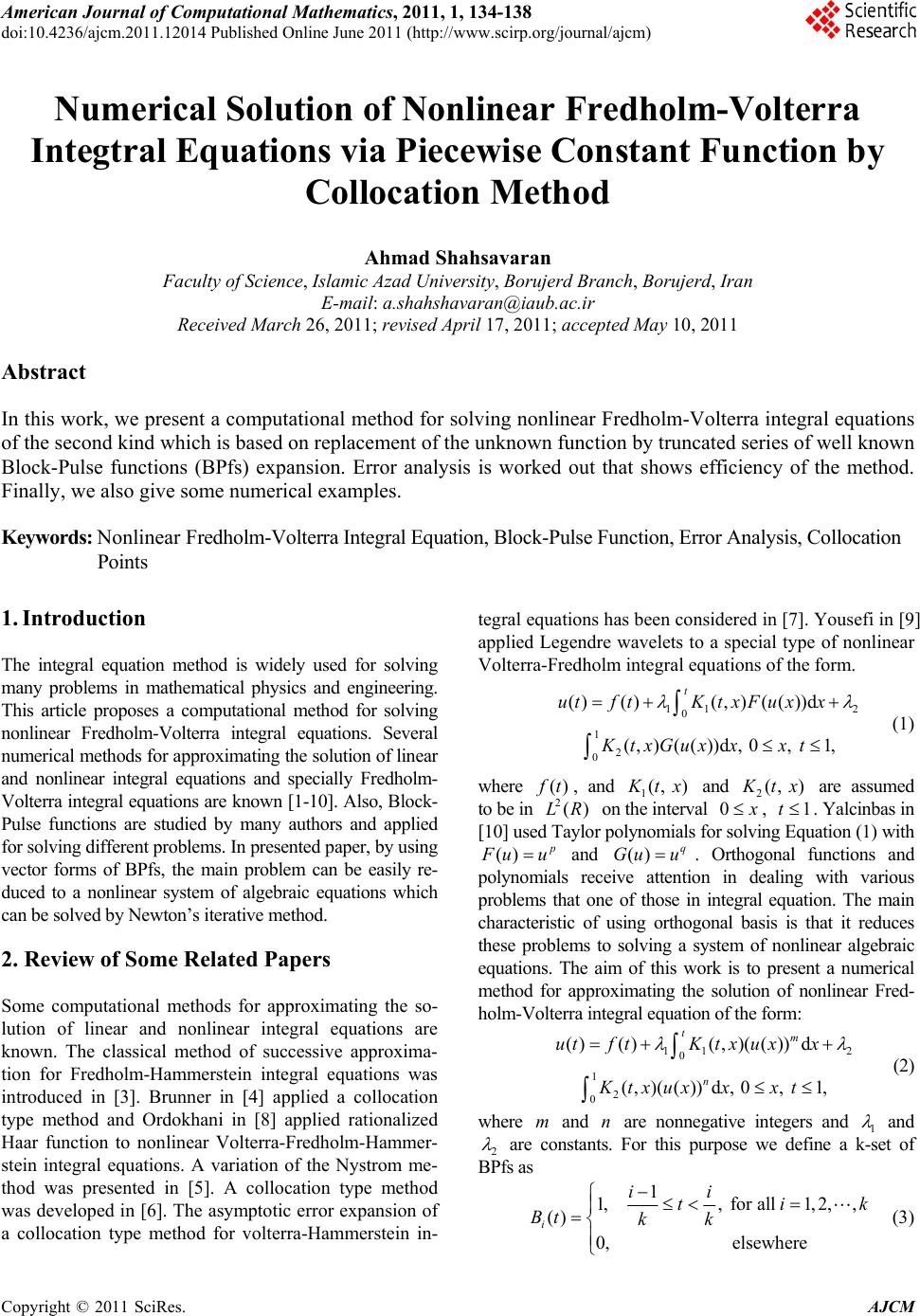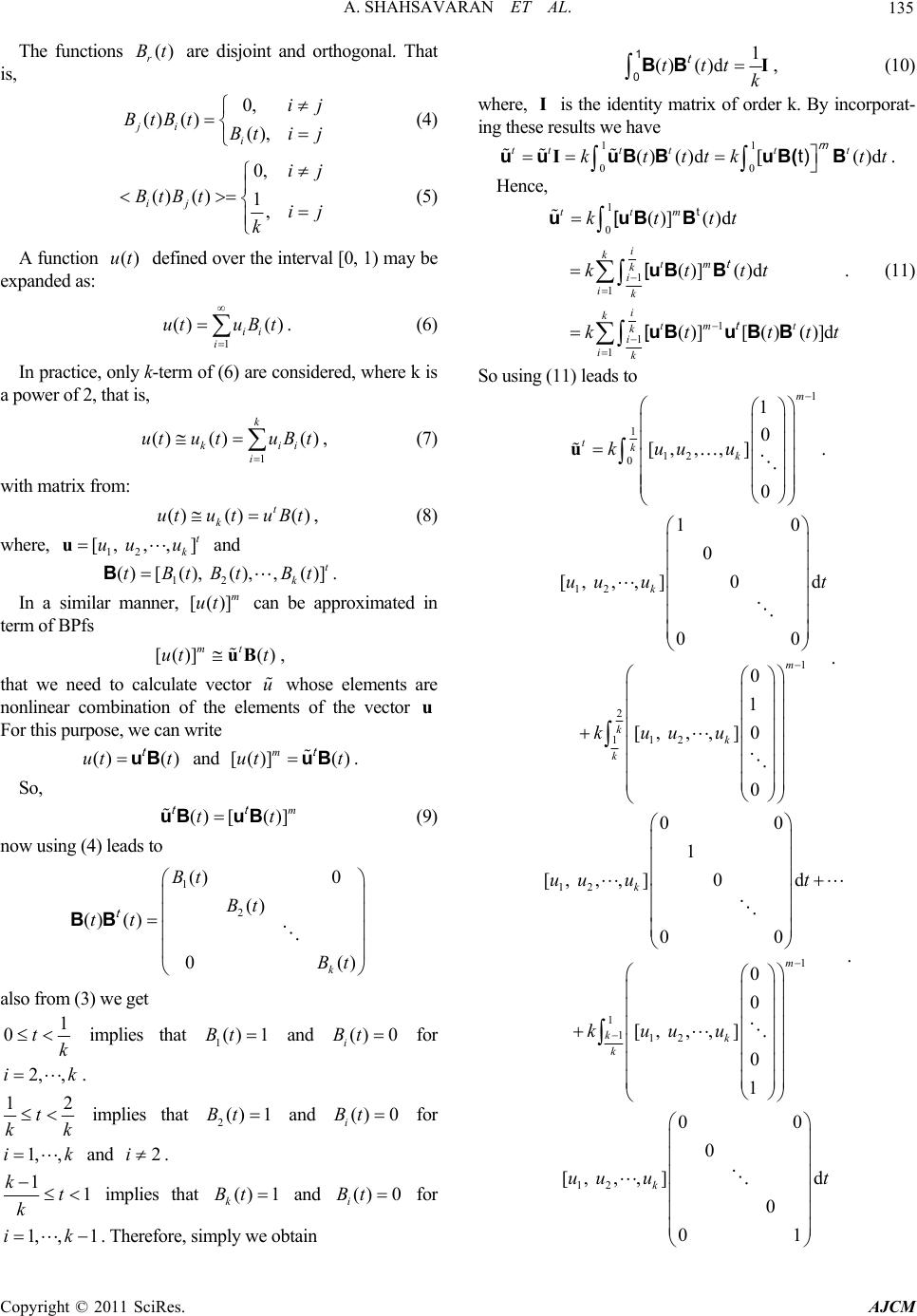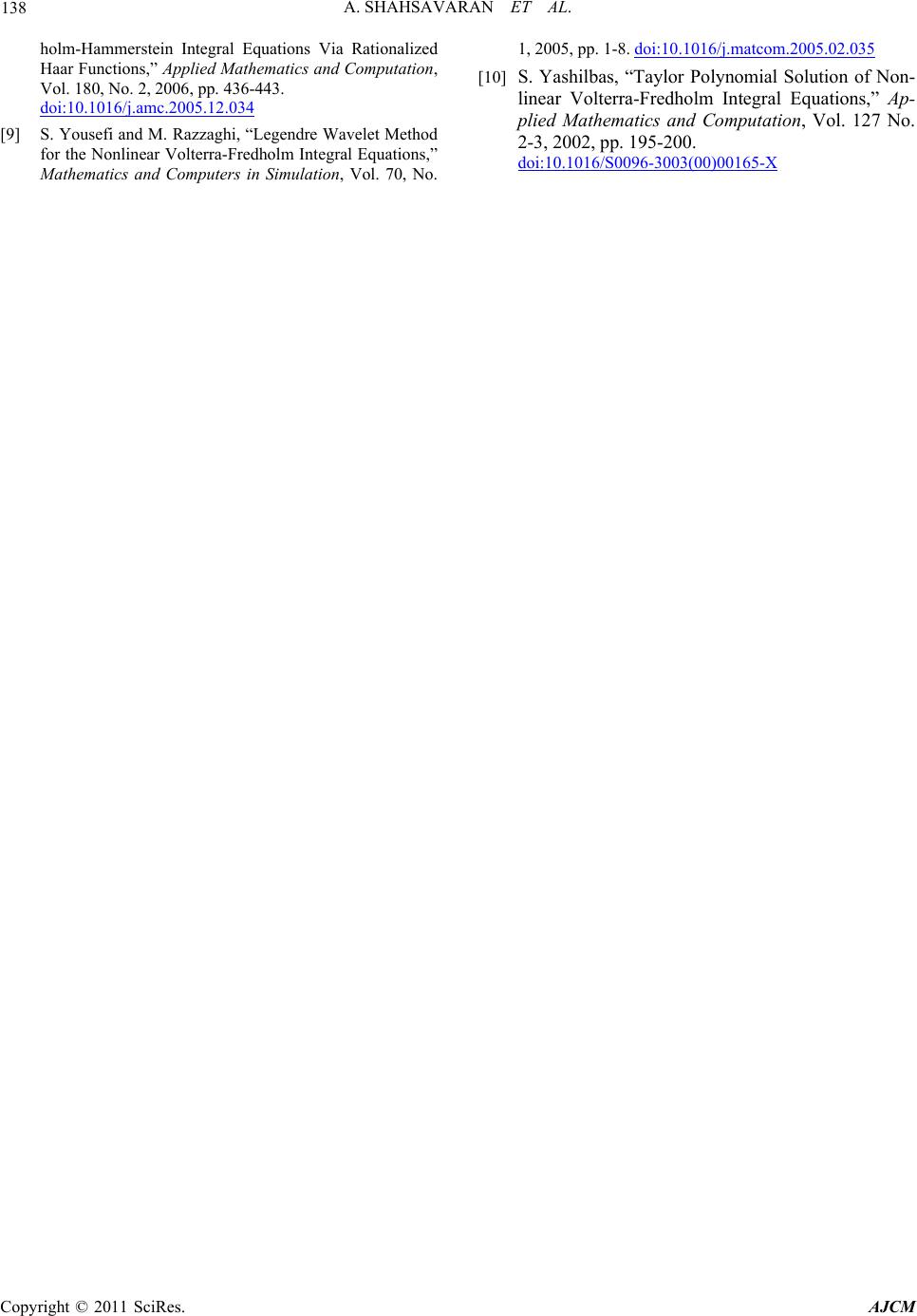 American Journal of Computational Mathematics, 2011, 1, 134-138 doi:10.4236/ajcm.2011.12014 Published Online June 2011 (http://www.scirp.org/journal/ajcm) Copyright © 2011 SciRes. AJCM Numerical Solution of Nonlinear Fredholm-Volterra Integtral Equations via Piecewise Constant Function by Collocation Method Ahmad Shahsavaran Faculty of Science, Islamic Azad University, Borujerd Branch, Borujerd, Iran E-mail: a.shahshavaran@iaub.ac.ir Received March 26, 2011; revised April 17, 2011; accepted May 10, 2011 Abstract In this work, we present a computational method for solving nonlinear Fredholm-Volterra integral equations of the second kind which is based on replacement of the unknown function by truncated series of well known Block-Pulse functions (BPfs) expansion. Error analysis is worked out that shows efficiency of the method. Finally, we also give some numerical examples. Keywords: Nonlinear Fre dh ol m- Vo lte rr a In te gral Equat io n, Bl ock- Pulse F unction, Error Analysis, Collocation Points 1. Introduction The integral equation method is widely used for solving many problems in mathematical physics and engineering. This article proposes a computational method for solving nonlinear Fredholm-Volterra integral equations. Several numerical methods for approximating the solution of linear and nonlinear integral equations and specially Fredholm- Volterra integral equations are known [1-10]. Also, Block- Pulse functions are studied by many authors and applied for solving different problems. In presented paper, by using vector forms of BPfs, the main problem can be easily re- duced to a nonlinear system of algebraic equations which can be solved by Newton’s iterative method. 2. Review of Some Related Papers Some computational methods for approximating the so- lution of linear and nonlinear integral equations are known. The classical method of successive approxima- tion for Fredholm-Hammerstein integral equations was introduced in [3]. Brunner in [4] applied a collocation type method and Ordokhani in [8] applied rationalized Haar function to nonlinear Volterra-Fredholm-Hammer- stein integral equations. A variation of the Nystrom me- thod was presented in [5]. A collocation type method was developed in [6]. The asymptotic error expansion of a collocation type method for volterra-Hammerstein in- tegral equations h as been considered in [7]. Yousefi in [9] applied Legendre wavelets to a special type of nonlinear Volterra-Fredholm integral equations of the form. 11 0 1 2 0 ()()(,)( ( ))d (,)(())d, 0, 1, t utf tKtxFuxx KtxGux xxt 2 (1) where () t, and 1(, ) tx and 2(, ) tx are assumed to be in on the interval 2(LR)0 1t, . Yalcinbas in [10] used Taylor polynomials for solving Equation (1) with () uu and () q Gu u . Orthogonal functions and polynomials receive attention in dealing with various problems that one of those in integral equation. The main characteristic of using orthogonal basis is that it reduces these problems to solving a system of nonlinear algebraic equations. The aim of this work is to present a numerical method for approximating the solution of nonlinear Fred- holm-Volterra integral equation of the form : 11 0 1 2 0 ()()(,)( ( ))d (,)(())d, 0, 1, tm n utf tKtxuxx Ktxux xxt 2 (2) where and are nonnegative integers and 1 m n and 2 are constants. For this purpose we define a k-set of BPfs as 1 1,, forall1,2,, () 0, elsewhere i ii ti Bt kk k (3)  A. SHAHSAVARAN ET AL. 135 j The functions are disjoint and orthogonal. That is, () r Bt 0, () ()(), ji i i BtBt Bti j (4) 0, () ()1, ij ij BtBt ij k (5) A function defined over the interval [0, 1) may be expanded as: ()ut 1 () () ii i utuB t . (6) In practice, only k-term of (6) are considered, where k is a power of 2, that is, 1 () ()() k ki i ututuB t i t ) , (7) with matrix from: () ()() t k ututuBt t , (8) where, and 12 [, ,,] k uu uu 12 ()[(), (),,()] t k tBtBt BtB m . In a similar manner, [( can be approximated in term of BPfs )]ut [()] () mt ut t uB u , that we need to calculate vector whose elements are nonlinear combination of the elements of the vector u For this purpose, we can write () ()ut t t uB and [( . )] () m ut t uB t So, () [()] m t uB uB tt (9) now using (4) leads to 1 2 () 0 () () () 0( k Bt Bt tt Bt t BB also from (3) we get 1 0tk implies that and 1() 1Bt() 0 i Bt for . 2, ,ik 1 t kk 2 implies that and 2() 1Bt() 0 i Bt for and . 1, ,ik 2i 11 kt k implies that and () 1 k Bt() 0 i Bt for . Therefore, simply we obtain 1, ,1ik 1 () ()dttt k IBB 1 0 t , (10) where, is the identity matrix of order k. By incorporat- ing these results we have I 11 00 () ()d[()d ttt ttt ktttk t I uuuBBuB( Bt) m t . Hence, 1 0 1 1 1 1 1 ()] ()d ()]()d ()][()()]d ttm i ktm k i ik i ktm t k i ik kttt kttt ktt t t uuBB uB B uBu BB t [ [ [tt . (11) So using (11) leads to 1 1 12 0 1 0 [, ,, ] 0 m tkk kuuu u. 12 1 2 12 1 10 0 [, ,,]d 0 00 0 1 [, ,,]0 0 k m kk k uu ut kuuu . 12 1 1 112 00 1 [, ,,]d 0 00 0 0 [, ,,] 0 1 k m kk k uu ut kuuu . 12 00 0 [, ,,]d 0 01 k uu ut Copyright © 2011 SciRes. AJCM  136 A. SHAHSAVARAN ET AL. 2 111 112 2 1 0 11 112 [0,,0]d[0, , ,0]d [0,,0, ]d[, ,,] mm k k k mmm kmm m k ku utkuut kuutuu u m t Now for evaluating the integral at the collocation point s 0() ()d tt tt BB 1 2 j j tk , 1, 2,,jk , (12) we may proceed as follows 1/2 1 00 0 2 1 11/2 21 1 2 0 1 () ()() ()d() ()d ()()d ()()d()()d 00 1d0 1d 0 0 00 00 jj ttt kk t k k jj tt kk jj kk k k k ttdtttt ttt ttt tttttt tt BBBB BB BB BB BB t 1 2 1/2 1 00 0 1d 0 00 00 0 01 1d 0 00 j k j k j j k j k t tk D (13) where, 1 [1, 1,,, 0,,0] 2 jkk Diag D, in fact, the diagonal matrix D, is defined as follows : 1, 2,,j 1,1, 2,1, 1,, 2 0,1,, . j mn mn j mnj mn jk 2 Also, may be approxim ated as: 2 (, )[0, 1)Kxt L kk 11 (, )()() ij i j ij xt KBxBt , or in matrix form (, )()() t xtx tBKB, (14) where 1, [] iji jk K K and 11 2 00 (, )() iji j kKxtBx B . ()ddtxt 3. Solution of the Nonlinear Fredholm- Volterra Integral Equations In order to use BPfs for solving nonlinear Fredholm- Voterra integral equations given in Equation (2), we first approximate the , ()ut () t, , , (()) m ux (()) n ux 1(, t ) and 2(, ) tx with respect to BPfs () ()ut tBu t t (15) () () ttBf (()) ( mt ux x uB (16) 1) (()) () nt ux x uB (17) 2 (, )() t (18) 1( ) 1 tx tBKxB (, )()() t (19) 22 txtxBKB (20) where k-vectors , , 1, 2, and matrices and are BPfs coefficients of , uf u ukk ()ut 1 K2 K() t, , , 1 (()ux) m(()ux) n(, ) tx and 2(, ) tx respectively. For solving Equation (2), we substitute (15-20) into (2), therefore 11 22 2 ()()()( )( )d ()()()d tt tt tt tttxx txxx t BuBf BKBBu BKBB u 0 1 0 1 x k , (21) We now collocate Equation (21) at k points , i t 1, 2,,j defined by (12) as 11 22 2 ()()()() ()d ()()()d tt tt jj j tt j ttt xx txxx j t BuBfBKBB u BKBB u 0 1 0 1 x (22) by using (10) and (13) and the fact that () j t Be where, e is the j-th column of the identity matrix of order k, Equati on (2 2) may then be restated as 12 1122 1, 2,,jk tj t ji jj uf kk eKDueKu , . (23) Equation (23) gi ves nonlinear equations w hi ch can k k Copyright © 2011 SciRes. AJCM  A. SHAHSAVARAN ET AL. 137 Table 1. t Exact A pp roxima t e for 8k Approximate for 16k 0.1 –1.99 –1.9847 –1.9876 0.2 –1.96 –1.9505 –1.9532 0.3 –1.91 –1.8857 –1.8905 0.4 –1.84 –1.7905 –1.8122 0.5 –1.75 –1.7650 –1.7666 0.6 –1.64 –1.6650 –1.6589 0.7 –1.51 –1.5091 –1.5080 0.8 –1.36 –1.3205 –1.3342 0.9 –1.19 –1.1103 –1.1297 Table 2. t Exact Approxima t e f o r 8k Approximate for 16k 0.1 0.0998 0.0625 0.0936 0.2 0.1986 0.1866 0.2070 0.3 0.2955 0.3078 0.2776 0.4 0.3894 0.4242 0.3952 0.5 0.4794 0.5139 0.5067 0.6 0.5646 0.5339 0.5596 0.7 0.6442 0.6353 0.6514 0.8 0.7173 0.7268 0.7243 0.9 0.7833 0.8069 0.7874 be solved for the elements using Newton’s iterative method. 1 u 4. Error in BPfs Approximation Theorem. If a differentiable function with bounded first derivative on (0, 1) is represented in a se- ries of BPfs over subinterval ()ut 1 [, ) ii kk , we have 1 ()( ) et Ok , where . ()() () k etutut Proof. See [1]. 5. Illustrative Examples Consider the following nonlinear volterra-Fredholm in- tegral equations. Example 1. 642 1 2 00 11 55 () 3033 4 ()[()]()[()], t uttt tt tx uxdxtx uxdx 0t, 1 . We applied the method presented in this paper for solving Equation (2) with and . 8k16k The computational results together with the exact so- lution are given in Table 1. 2 () 2ut t Example 2. 2 0 111 () sinsin2[()]d 842 t uttttux x ,0t ,1 . The computational results with and 8k16k together with the exact so lution are given in Table 2. ()ut sint 6. Conclusions The aim of present work is to apply a method for solv ing the nonlinear Volterra-Fredholm integral equations. The properties of the Block Pulse functions together with the collocation method are used to reduce the problem to the solution of nonlinear algebraic equations. Example 1 is solved in [2] using Chebyshev expansion method (Cem), comparing the results shows Cem is more accurate than BPfs method But, it seems the number of calculatio ns of BPfs method is lower. Also, the benefits of this method are low cost of setting up the equations due to properties of BPfs mentioned in Section 2. In addition, the nonlin- ear system of algebraic equations is sparse. Finally, this method can be easily extended and applied to nonlinear Volterra-Fredholm integral equations of the form Equa- tion (1). Illustrative examples are included to demon- strate the validity and app licability of the technique. 7. References [1] A. Shahsavaran, E. Babolian, “Numerical Implementation of an Expansion Method for Linear Volterra Integral Equations of the Second Kind with Weakly Singular Kernels,” International Journal of Applied Mathematics, Vol. 3, No. 1, 2011, pp. 1-8. [2] E. Babolian, F. Fattahzadeh and E. G. Raboky, “A Che- byshev Approximation for Solving Nonlinear Integral Equations of Hammerstein Type,” Applied Mathematics and Computation Vol. 189, No. 1, 2007, pp. 641-646. doi:10.1016/j.amc.2006.11.181 [3] F. G. Tricomi, “Integral equations”, Dover, 1982. [4] H. Brunner, “Implicity Linear Collocation Method for Nonlinear Volterra Equations,” Applied Numerical Ma- thematics, Vol. 9, No. 3-5, 1982, pp. 235-247. doi:10.1016/0168-9274(92)90018-9 [5] L. J. Lardy, “A Variation of Nysrtom’s Method for Hammerstein Integral Equations,” Journal of Integral Equations, Vol. 3, No. 1, 1982, pp. 123-129. [6] S. Kumar, I. H. Sloan, “A New Collocation—Type Method for Hammerstein Integral Equations,” Journal of Computational Mathematics, Vol. 48, No. 178, 1987, 585-593. [7] H. Guoqiang, “Asymptotic Error Expansion Variation of A Collocation Method for Volterra—Hammerstein equa- tions,” Applied Numerical Mathematics, Vol. 13, No. 5, 1993, pp. 357-369. doi:10.1016/0168-9274(93)90094-8 [8] Y. Ordokhani, “Solution of Nonlinear Volterra-Fred- Copyright © 2011 SciRes. AJCM  A. SHAHSAVARAN ET AL. Copyright © 2011 SciRes. AJCM 138 holm-Hammerstein Integral Equations Via Rationalized Haar Functions,” Applied Mathematics and Computation, Vol. 180, No. 2, 2006, pp. 436-443. doi:10.1016/j.amc.2005.12.034 [9] S. Yousefi and M. Razzaghi, “Legendre Wavelet Method for the Nonlinear Volterra-Fredholm Integral Equations,” Mathematics and Computers in Simulation, Vol. 70, No. 1, 2005, pp. 1-8. doi:10.1016/j.matcom.2005.02.035 [10] S. Yashilbas, “Taylor Polynomial Solution of Non- linear Volterra-Fredholm Integral Equations,” Ap- plied Mathematics and Computation, Vol. 127 No. 2-3, 2002, pp. 195-200. doi:10.1016/S0096-3003(00)00165-X
|